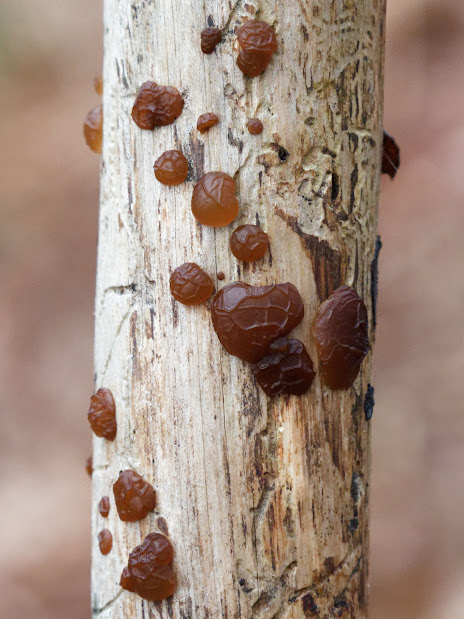From the car park we joined the disused railway track( nicknamed Castleman’s Corkscrew) and now a cycle track. We headed west initially across open ground, the track lined by small thorny trees with Early Dog Violet in flower, where we saw House Martin, Robin, Chaffinch, Chiffchaff, Woodpigeon, Buzzard, Bullfinch and Long-tailed Tit.
 |
|
Long-tailed Tit © Glynis Payne |
 |
|
Common Dog-violet © Chris Robinson |
Passing under a road bridge, the track entered a wooded cutting within Setthorns enclosure. Historically railways avoided the fire-risk of woodland, but the line was laid here to avoid Hinchelsea Bog and Wilverley enclosure. The north-facing bank was home to a rich tapestry of ferns including Male Fern, Hard Fern and Hart's-tongue Fern. A Dor Beetle, Nuthatch and Treecreeper were seen.
Turning right into the camp site we
stopped to watch a pair of Blue Tits nesting in a hole in an oak and saw a
Long-tailed Tit collecting lichen for its nest. Taking a small path in the
north-west corner of the campsite, heading towards Yew Tree Bottom, we soon
stopped to rest on a large fallen tree, where Turkeytail and Pine Jelly Exidia saccharina, a rare species, were seen. 
Black Spleenwort © Chris Robinson
Pine Jelly © Richard Smith
As we
emerged from the scrub to an open area, a Rabbit was seen. We then took the
left hand fork, uphill back to cross the cycle track as a Swallow flew
overhead. We turned left on a path back towards the car park, passing Yellow
Brain fungus growing on a fallen tree. A boggy area was rich in Sphagnum Moss
(this was gathered from The New Forest during the First World War as an
antiseptic wound dressing capable of holding 25 times its weight in liquid). Male
and female Goat Willow trees were in flower and their differing flower
structures studied; a Brimstone Butterfly was seen.
 |
| Goat Willow - male flower © Richard Smith |
 |
| Goat Willow - female flower © Richard Smith |
As the path climbed, we looked back at the lovely view over to the course of the Avon Water, studying an early nineteenth century map to see which paths and river crossings remain today. Meanwhile, a single Carrion Crow tried unsuccessfully to mob two Ravens above our heads, and Goldfinches, Greenfinches and a Minotaur Beetle were seen.
Keeping to the central path we re-joined the cycle track and retraced our steps back to Longslade, hearing a Coal Tit, and seeing Pheasant, Long-tailed Tits, a pair of Robins and a freshly built nest made of a ball of moss (possibly Chaffinch?).
At Longslade a Goshawk was seen carrying a small mammal prey. Some of the group extended the walk a little further along the cycle track, finding Great Tit and Goldcrest and Wild Strawberry in flower. JR&AJ
ReferencesOur route
© Crown copyright 2023 Ordnance Survey. Media 006/23.
The licence is valid until 31 December 2023
http://www.newforestexplorersguide.co.uk/heritage/history-in-the-landscape/castlemans-corkscrew.html .
http://www.newforesthistoryandarchaeology.org.uk/historic-maps.html

